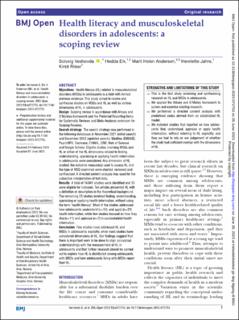| dc.description.abstract | Objectives Health literacy (HL) related to musculoskeletal disorders (MSDs) in adolescents is a field with limited previous evidence. This study aimed to review and synthesise studies on MSDs and HL as well as various dimensions of HL in adolescents.
Design Scoping review in accordance with Arksey and O’Malleys framework and the Preferred Reporting Items for Systematic Reviews and Meta-Analyses extension for Scoping Reviews.
Search strategy The search strategy was performed in the following databases in November 2021 (initial search) and December 2022 (updated search); Medline, EMBASE, PsychINFO, Cochrane, CINAHL, ERIC, Web of Science and Google Scholar. Eligible studies involving MSDs and HL or either of the HL dimensions related to finding, understanding, appraising or applying health information in adolescents were considered. Any dimension of HL studied, the outcome measure(s) used to assess HL and the type of MSD examined were charted, reviewed and synthesised. A directed content analysis was used for the subjective interpretation of text data.
Results A total of 16 841 studies were identified and 33 were eligible for inclusion. Ten articles presented HL with a definition or description in the theoretical background. The remaining 23 studies involved finding, understanding, appraising or applying health information, without using the term ‘health literacy’. Most of the studies addressed how adolescents understand (n=32), and apply (n=23) health information, while few studies focused on how they find (n=11) and appraise (n=7) musculoskeletal health information.
Conclusion Few studies have addressed HL and MSDs in adolescents explicitly, while most studies have considered dimensions of HL. Our findings suggest that there is important work to be done to align conceptual understandings with the measurement of HL in adolescents and that further research should be carried out to explore how HL is distributed among adolescents with MSDs and how adolescents living with MSDs report their HL. | en_US |

